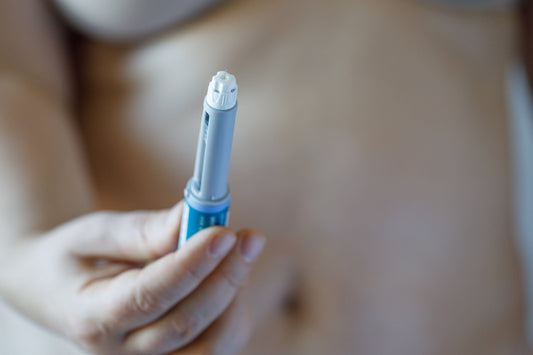When we experience thinning hair, whether it’s related to menopause or not, it can have a damaging effect to our self-esteem and confidence. While hair thinning is commonly experienced by both men and women, there are several reasons as to why women specifically may experience hair loss, and they may surprise you. Read on to learn more about why you may be experiencing hair thinning and what you can do to address it.
What are the Phases of Hair Growth?
To better understand the different causes of hair thinning, it may help to better understand the four phases of a normal hair growth cycle1:
- It starts with the anagen phase, better known as the growth phase. This first phase can last anywhere from 3-5 years and at any given time, about 90% of the hair on our head is in this phase. Anagen begins with the scalp pushing out new hair follicles, which continue to grow until the shedding phase (the fourth phase) or until they are cut.
- The second phase is the catagen or transitional phase, which lasts around 10 days and is where the hair follicles shrink, and hair growth subsides.
- The third phase is telogen, which lasts around 3 months and is when the follicle is at rest and no growth is occurring.
- Exogen or the shedding phase, is the fourth and final stage of hair growth, where hair is shed from the scalp – after this phase, the process starts again.
What Causes Thinning Hair in Women?
Although we may not like to think so, thinning hair in women is considered normal, with about 50% experiencing some level of hair loss by the age of 50. It can also become more evident during and after menopause because of hormone fluctuations experienced during this time. In fact, it’s been found that by the age of 60, about 80% of women will have experienced some form of hair loss.2
Hair strands themselves may become finer and wispier and may fall out more easily as a result of hormonal changes during menopause, – mainly less estrogen and progesterone and more androgens (male hormones) – follicle size may also be reduced.3 As our hair strands become finer, we can also lose the appearance of volume.
While hormone shifts certainly impact hair thinning, maintaining optimal blood flow to hair follicles can also affect the health of your hair. Blood flow to hair follicles tends to slow down with age, which can negatively impact hair growth and expedite loss. Due to this lack of blood flow, your strands may have restricted access to key hair nutrients, such as vitamins A (beta carotene) and C and omega-3 fatty acids,4 which can contribute to hair thinning.
Outside of hormonal fluctuations and shifts in blood flow, there are several other factors that can contribute to hair thinning in women.
Thyroid Imbalance
Your thyroid regulates your metabolism and plays an important role in supporting many critical body functions through the constant release of thyroid hormones.5 A sluggish thyroid that releases less hormones than usual (a condition known as hypothyroidism), can cause brittle or thinning hair to occur on the scalp and body. The opposite, which is characterized by an overactive thyroid (known as hyperthyroidism), can also cause hair to become dry, brittle or thin.6 These conditions are important to note as thyroid issues tend to affect women more often than men; with women being anywhere from 5 to 8 times more likely to develop one.7
Female Pattern Hair Loss
Just as with men, women can experience “balding,” but it’s more commonly referred to as female pattern hair loss. This condition is characterized by the visible loss of hair along with thinning around the crown. Women may notice the first sign of female pattern hair loss as a widening in her part or a smaller width in her ponytail.8
Diet, Alcohol and Tobacco Intake
Healthy hair growth is largely due to our ability to maintain adequate nutrition. When our diets are lacking in key hair nutrients, such as vitamins A and D, as well as iron and protein, hair thinning, loss and shedding can result.9
Drinking alcohol in excess can be detrimental to hair health as well. It can be a contributing factor to hair thinning, as consuming too much can lead the malabsorption of certain key nutrients.10 The same can be said for smoking cigarettes, which has been shown to not only damage the hair follicle, but it can also impede blood flow to the follicle, limiting the amount of nutrients delivered.11
Stress
A common culprit responsible for many discomforts in life is stress, which can also be the root cause of hair thinning. High levels of stress hormones have been shown to cause hair follicles to enter the telogen phase (no growth) before they are ready,12 where simple acts such as getting dressed, combing your hair or taking a shower, can pull hairs out easily.
Hair Styling
Believe it or not, the way you style your hair can also impact hair thinning. Tight ponytails can rip the hair from the follicle, and the routine use of excessive heat and chemicals can reduce hair follicle size and amounts. Women who frequently wear tight braids, weaves or extensions that pull the hair too tightly, can also be at an increased risk of hair thinning and loss.13
Hair Shedding vs. Hair Thinning
While it is normal to drop anywhere up to between 50 and 100 hair strands per day,14 you may occasionally notice more hair than usual in the drain, on the floor, on your clothing and in your brush. Rest assured, there is an explanation for this, too.
This robust exogen phase (which in medical terms is referred to telogen effluvium) tends to be short term and is often triggered by intense periods of stress, weight loss, when a woman stops taking birth control pills, as well as because of pregnancy and post-pregnancy, due to hormonal fluctuations.15 This form of hair shedding can normally resolve itself after the body readjusts from a stressor or pregnancy. If the stressor remains, however, the hair loss can last longer.16 If you think you’re experiencing hair shedding, and it’s a concern, be sure to check in with your healthcare provider or a dermatologist to determine the best ways to address it.
What Can Women Do for Thinning Hair?
If you’re currently struggling with thinning, there are a variety of things you can do to better support your hair health.
First, take a look at your hair styling routine. If there is anything damaging or harsh about it, consider working with your stylist to find a look that requires fewer chemical or heat elements. You can also try loosening your ponytail or bun for a softer look and to take the stress off your follicles.
As our thyroid plays a role in our hair health, if you have any concerns about how yours is functioning, be sure to check in with your healthcare provider. They can easily test your blood to determine the amounts of hormones being released by your thyroid gland, enabling them to detect any issues and treat them accordingly.
Revisiting what you’re eating daily can certainly help support better hair health, too. Consider switching to a heart healthy, nutrient rich diet, such as the Mediterranean diet, to support your hair health and maintain better overall health and wellness. You can also consider adding in specific dietary supplements if you’re not getting enough nutrients through your diet alone.
Other tips to nourish your hair from the inside include evolving older lifestyle habits into healthy, vibrant ones. If you smoke, quit. Reduce stress levels by trying out meditation or yoga and consider switching to mocktails or zero-proof beverages instead of alcohol.
Understanding the reasons why your hair is thinning is half the battle. Now that you know the key causes, you can take a proactive approach to better supporting your hair health throughout menopause and beyond.
Resources
- https://www.healthline.com/health/stages-of-hair-growth#maintaining-hair-health
- https://www.everydayhealth.com/menopause/help-for-hair-thinning-in-midlife/
- https://my.clevelandclinic.org/health/diseases/16921-hair-loss-in-women
- https://www.webmd.com/beauty/ss/slideshow-foods-healthy-hair
- https://www.ncbi.nlm.nih.gov/books/NBK279388/
- https://www.healthline.com/health/thyroid-and-hair-loss#_noHeaderPrefixedContent
- https://www.thyroid.org/media-main/press-room/#:~:text=Prevalence%20and%20Impact%20of%20Thyroid%20Disease&text=Women%20are%20five%20to%20eight,percentage%20can%20be%20very%20aggressive.
- https://www.sciencedaily.com/releases/2010/03/100306143329.htm
- https://www.ncbi.nlm.nih.gov/pmc/articles/PMC4828511/
- healthline.com/health/alcohol-and-hair-loss
- https://pubmed.ncbi.nlm.nih.gov/12673073/
- https://www.wellandgood.com/how-to-reverse-stress-related-hair-loss/
- https://www.healthline.com/health/traction-alopecia#causes
- https://my.clevelandclinic.org/health/diseases/16921-hair-loss-in-women
- https://www.healthline.com/health/hair-loss-in-pregnancy
- https://www.aad.org/public/diseases/hair-loss/insider/shedding

-v1645131697587.png?2084x2269)








